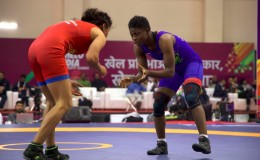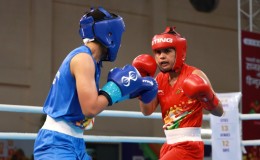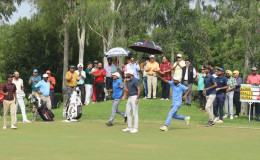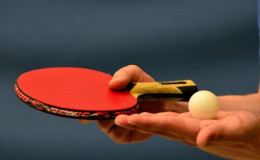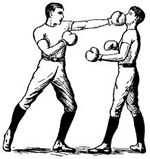
- Boxing, also called pugilism, is a combat sport in which two people fight each other using their fists.
- Boxing is supervised by a referee over a series of between one to three minute intervals called rounds.
- The match ends, when an opponent is knocked out or deemed incapable to continue match by a referee (Technical Knockout), if an opponent is disqualified for breaking a rule, resigning by throwing in a towel, or by judges' scorecards at the end of the bout.
- There are two forms of boxing, amateur and professional.
Area and Equipments:
- Boxing is played in a square box with four corners and ropes tied to them known as the boxing ring.
- The dimension of the ring is 15X15 for amateurs, 18X18 for International level and 20X20 for pro level.
- Boxers use wrist wraps to secure the bones in hand.
- Gloves are used to avoid blunt injury on the hand and fist.
- A mouth guard protects the teeth and gums from injury, and to cushion the jaw.
- Headgear to prevent head injury (amateur boxing).
Categories:
For Elite Men and Youth Boxers (Boys):
• 46 kg - 49 kg, 52 kg, 56 kg, 60 kg, 64 kg, 69 kg, 75 kg, 81 kg, 91 kg, 91+ kg.
• For Elite Women and Youth Boxers (Girls):
• 45 kg - 48 kg, 51 kg, 54 kg, 57 kg, 60 kg, 64 kg, 69 kg, 75 kg, 81 kg, 81+ kg
For Elite Women 3 Weight Categories for the Olympic Games shall apply as follow:
• 48 kg to 51 kg, 57 kg to 60 kg, 69 kg to 75 kg
Rules:
The rules of boxing depend on the jurisdiction of the boxing match, the boxing association and also the category i:e Pro or Amateur. However these are few basic rules which apply in all forms:
- Hitting the opponent’s back or the back of his head or neck is disallowed. This has probably to do with the fact that a punch to the back of the head or when an opponent is not facing can result in serious injury.
- If an opponent is floored otherwise called a knockdown or knock him down, the guy standing must go to the farthest neutral corner while the referee makes a count or checks on the health of your opponent.
Most of the referee counts are up to 10 seconds during which your opponent is allowed to recover failing to recover results in a knockout. If a boxer is knocked out of the ring, the boxer has a count of 20 to get back on his feet and in the ring. - One cannot use head shoulder, forearm or elbow to hit. Biting off the ears of is not allowed. Hitting below the belt, holding, tripping, kicking, and head butting, wrestling or pushing the opponent is considered foul and can result in point deduction or simple disqualification.
If an opponent is hit below the belt, he has the right to rest for 5 minutes as he recovers. An accidental blow also gives the boxer 5 minutes to recover. - It is against the rules of boxing to hit the opponent with an open glove, the wrist, the backhand or the side of the hand. Boxing is not a slapping contest.
- It is illegal in boxing to throw a punch while holding on to the ropes to gain leverage for the punch. In fact even holding on to the opponent while hitting him is illegal. However, it becomes hard to referee this rule as in the heat of the moment; a boxer will just do it.
- If a referee breaks a hold, or a clinch, both boxers are supposed to take a step back before they can engage again. Hitting back or immediately hitting each other after the referee has broken a clinch is frowned upon by boxing purists.
- If foul results in an injury that causes the fight to end, the boxer who committed the foul is disqualified. If the injury did not cause the fight to end, the referee orders the judges to deduct two points from the offender.
- If the foul was unintentional, the bout is ruled as a no decision, if four rounds had not been completed. If the four rounds are completed, the fighter with the most points at the time is awarded a technical decision. If the scores were even, then it’s a technical draw. Depending on the boxing jurisdiction, there are many variations to this rule including the standing count which can vary from 8 to 10 and even the number of rounds in a match. But the basic boxing rules above apply in most boxing matches.
Rules and regulations (Amateur boxing)
Amateur boxing has a minimum age that states that you must be at least 11 years old to compete, but there is no minimum training age.
Seniors
1. A Boxer becomes a Senior on his 17th birthday. When he reaches his 34th birthday, he will no longer be allowed to box, and his ME3 must be returned to his Association for cancellation.
Round Duration
2. Boxers will box 3 x 2 minute rounds and males may box 4 x 2 minute rounds or 3 x 3 minute rounds by agreement. Females may box 4 x 2 minute rounds by agreement. In Open Championships and Internationals, males will box 3 x 3 minute rounds and females 4 x 2 minute rounds. In every case there will be an interval of one minute between rounds.
3. A Senior Boxer may participate in a maximum of 18 contests per season excluding Championships and International matches.
Classification
4. There shall be three classes of Senior Boxers. The appropriate classification being:
(a) Novice
A Novice is a boxer who has not competed in any stage of an Open Senior Championship. A Novice Boxer must not compete against an Open Class Boxer other than in recognized Championship.
(b) Intermediate
An Intermediate is a Boxer who has:
(a) entered and competed in an Open Senior Championship but has not won a Regional Association Title,
(b) won a Novice Class ‘B' Title,
(c) won a CYP Class C Title, or
(d) returned from professional boxing. ~s
(c) Open
An Open is a Boxer who has:
(a) won an ABAE Senior Championship Regional Association Title.
(b) boxed at Senior level for his Country.
A Regional Association Executive Committee may upgrade a Boxer who in their opinion, is clearly above the prevailing standard for his current level of classification. Similarly, a boxer may be downgraded if his ability, in their opinion is below the standard prevailing in his current classification.
Juniors
1. A boxer is a junior from his 11th birthday (at which age he is eligible to hold an ME3), until his 17th birthday.
2. (a) Boxers under the age of 17 years MUST NOT concede more than 12 months in age, except where necessary for specific International Events.
(b) Novice boxers aged 17 years can compete against boxers aged 16 years provided 43 there is no more than 12 months difference in age.
(c) It is recommended that Junior boxers do not concede age, weight and experience in a contest. The final decision for any contest is the responsibility of the OIC.
Rounds Duration
2. Unless the conditions for Championships or other authorised events prescribe otherwise the duration of bouts for Junior boxers will be as follows:
Both boxers aged over 11 years and under 14 years: 3 x 1.5 minute rounds
One boxer aged 13 and the other 14 years: 3 x 1.5 minute rounds
Both boxers aged 14 years: 3 x 2 minute rounds
One boxer aged 14 years and the other 15 years: 3 x 2 minutes rounds
Both boxers aged 15 years or over: 3 x 2 minute rounds, or 4 x 2 minutes by agreement. 3 x 3 minute rounds by agreement (male boxers only)
Professional boxing
Format
The number of rounds in a boxing match varies depending on the sanctioning body and the significance of the fight. A professional International Boxing Federation championship fight will always last 12 rounds, barring a knockout. Each of these rounds is three minutes long. At the end of every round, the fighters return to their corners and rest for one minute before continuing on with the next round.
Strikes
All fighters who weigh in at 155 lb. or more fight with 10 oz. gloves, while fighters who weigh in at under 155 lb. fight with 8 oz. gloves. Boxers are only allowed to strike with the gloves. Blows must be delivered above the waist, and cannot land on the back of the fighter at any height. A referee can deduct points for illegal blows or disqualify a fighter if the fouls are severe and intentional.
Knockouts
Fighters can stop a fight with a knockout or technical knockout. When a fighter is knocked down, the referee gives the fighter eight seconds to return to his feet and demonstrate that he can continue. If the fighter can't do so, the fight is stopped. Referees can stop a fight at any time if they feel a fighter's safety is in jeopardy. While the fighter might not be unconscious, a technical knockout can be declared.
Scoring
Professional boxing matches are scored on a 10-point must system. Each bout has three judges, who award the winner of the round 10 points and the loser 9 points or less depending on how evenly matched the round was. At the end of the fight, the points are totaled for a decision. It's a unanimous decision if all judges agree, a split decision if one judge awards the fight to a different fighter, and a majority decision if one judge scores a draw and the others declare the same winner. The fight is a draw if two judges score it a draw, or if one judge scores it a draw and the other two are split in declaring the winner.
Governing bodies:
International Amateur Boxing Association (AIBA).
British Boxing Board of Control
Nevada State Athletic Commission
European Boxing Union
Sanctioning body:
World Boxing Association (W.B.A.)
World Boxing Council (W.B.C.)
International Boxing Federation (I.B.F.)
World Boxing Organization (W.B.O.)
Tournaments:
Olympics
World Boxing Championships



